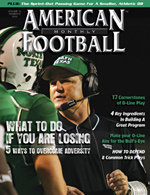Article CategoriesAFM Magazine
|
Give Your O-Line a Bull’s-Eyeby: Rick FoxOffensive Line and Special Teams Coach, Drake University © More from this issue As a young coach in the late ‘80’s, I was introduced to the article “The Eyes Lead the Body” by Blanton Collier. Little did I realize then how significant that article is for offensive line success. Later in my coaching career at Centre College in Danville, KY where, like most Division III schools, coaches often wear many hats. I served as a strength and conditioning coach in addition to offensive coordinator. In that role, I found I was often coaching posture in order for athletes to maximize their power output. In doing so, I was reminded again of the importance of the eyes. In my experience, I have realized that coaching the eyes is often overlooked, or at the very least, underemphasized. Why Coaching the Eyes is Important How many of us have heard the Little League coach yell to the....The full article can only be seen by subscribers.
|
|
|||||||
| HOME |
MAGAZINE |
SUBSCRIBE | ONLINE COLUMNISTS | COACHING VIDEOS |
Copyright 2026, AmericanFootballMonthly.com
All Rights Reserved





